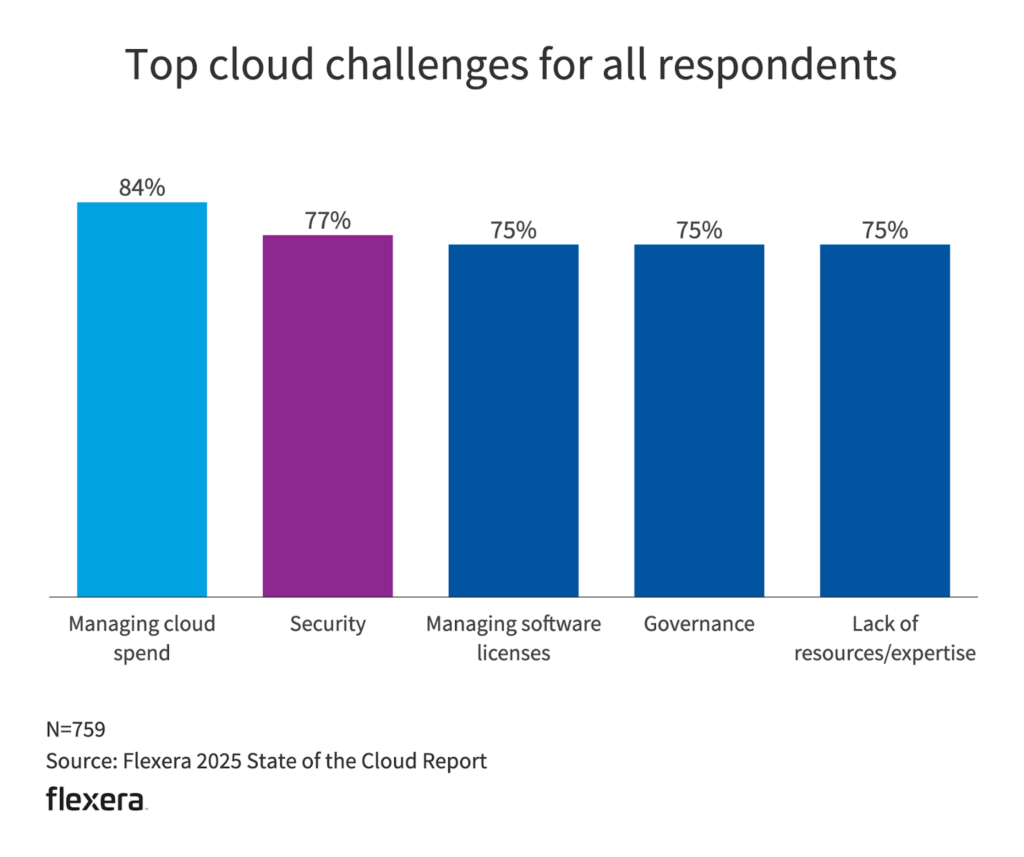Scaling on the cloud sounds easy. . .until the bills spike and systems stall. This post breaks down how leading enterprises balance flexibility and cost without sacrificing speed.
The Cloud Adoption Imperative (2025 View)
It’s 2025, and cloud isn’t a strategy discussion anymore. It’s essentially what the air enterprise runs on.
From AI training to global scale to hybrid teams, cloud is the backbone for speed, resilience, and intelligent systems. In 2025, enterprise agility depends on whether your cloud architecture accelerates or anchors growth.
State of Cloud: Key Statistics (2025)
- Worldwide public cloud spending expected to reach $723 billion in 2025, marking a 21.5% YoY rise
- 33% of organizations will spend over $12 million in public cloud annually in 2025, up from 29% in 2024
- 70% of enterprises are embracing hybrid cloud strategies, using ≥1 public + ≥1 private cloud
- Over 80% are employing or piloting generative AI services in the cloud
Modern enterprise teams are building with this context in mind. The pressure isn’t just to be cloud-enabled — it’s to be cloud-strategic. Understanding where the market is heading helps anchor decisions not in hype, but in operational reality.
What Is Strategic Cloud Adoption?
Strategic cloud adoption means more than just “moving to the cloud.” It’s about designing systems, costs, and capabilities around long-term outcomes, and not just short-term migrations. Done right, it aligns technical flexibility with business resilience.
Instead of lift-and-shift rehosting, strategic adoption involves:
- Choosing architectures that evolve with your needs
- Managing cost with visibility and automation
- Embedding AI to optimize operations, not just analytics
- Adopting modular, scalable design from day one
It’s a mindset: Cloud as a growth enabler, not just infrastructure. Strategic adoption puts architecture at the center of value delivery.
Hidden Costs of Cloud Hype
The myth: Cloud saves money.
The reality: Poorly managed cloud can quietly devour budgets.
Dropbox’s high-profile cloud repatriation is a cautionary tale. Despite massive scale, they moved workloads back on-prem to regain cost control. Why? Overprovisioning, uncontrolled egress, and inefficiency at scale.
Cloud cost overruns often stem from:
- Underused instances running 24/7
- High egress fees when pulling data across regions or providers
- Redundant environments (dev, staging, prod) not being rightsized
According to Flexera’s 2025 State of the Cloud Report, 84% of enterprises cite managing cloud spend as their top cloud challenge.

But cost isn’t the only trap — it’s the lack of visibility. Without proactive monitoring, cloud environments can become financial black holes. Teams don’t see waste until it’s embedded in spend. Strategic adoption means using observability not just for uptime, but for cost governance.
Done right, cloud spending should scale with impact, not surprises.
Scalability Isn’t Free. It’s Smart Design
Cloud makes scaling easy in theory. But in practice, we see scale as a design problem.
Think about it: The architecture that supports your first 10,000 users might buckle at 100,000.
True scalability demands proactive planning:
Horizontal vs vertical scaling
Know when to add power vs add nodes
Autoscaling policies
Tune thresholds, cool-down periods, and observability
Container orchestration
Use Kubernetes or ECS to modularize scaling logic
Infrastructure-as-code (IaC)
Automate repeatable, versioned environments
So you see, scaling is not just about capacity. It’s about orchestration.
Too many teams ship first and optimize later. But retrofitting scalability after growth hits is costlier and riskier than building it in upfront.
AI’s Role in Strategic Cloud Management
Until now, we’ve looked at cost and scalability through the lens of architecture and planning. But what happens when your infrastructure starts handling thousands of workloads, dozens of services, and near-real-time traffic across multiple regions?
That’s where AI steps in.
AI doesn’t just live in the cloud. It runs the cloud.
Today’s advanced platforms use AI and machine learning for:
- Predictive autoscaling (e.g., Google Cloud’s Autopilot)
- Workload optimization (e.g., AWS Compute Optimizer)
- AIOps-driven incident response
These tools help teams:
- Detect anomalies before they become outages
- Auto-rightsize instances based on usage trends
- Reduce latency and improve cost/performance ratios
Cloud Strategy as a Competitive Edge
A strong enterprise cloud strategy isn’t just about tools, but also about maturity. The Cloud Maturity Model breaks this into phases:
- Lift-and-Shift — basic migration, often rehosting legacy systems
- Cloud-Native — containerized, modular apps using cloud-native services
- Intelligent Cloud — AI-managed, cost-optimized, and user-centered
Firms that progress faster through this model don’t just save money. They build:
- Faster delivery cycles
- More resilient infrastructure
- Greater experimentation capacity
FAQs
What are the main costs associated with cloud adoption?
Core costs include compute, storage, bandwidth, and egress. Hidden costs stem from overprovisioning, idle resources, data duplication, and misconfigured services.
How can businesses optimize cloud spending?
Audit workloads regularly. Use reserved instances, autoscaling, and observability tools. Shut down unused environments.
Is multi-cloud better than single-vendor cloud strategies?
Multi-cloud offers redundancy and flexibility but adds complexity. Hybrid is often a strategic middle ground.
How does AI impact cloud cost and scalability?
AI helps predict usage, auto-tune resources, and prevent outages — directly influencing cost and uptime.
What is the most scalable cloud architecture?
Containerized microservices managed via Kubernetes or similar platforms offer modular, elastic scalability.
Conclusion: Cloud Strategy Is Architecture Strategy
Adopting cloud is easy. Using it strategically? That takes discipline.
Cloud platforms should evolve with your business, not overwhelm it. That means aligning teams, planning for cost, designing for scale, and embedding AI into operations.
If your cloud feels bloated, brittle, or just confusing, our team helps make it make sense.

